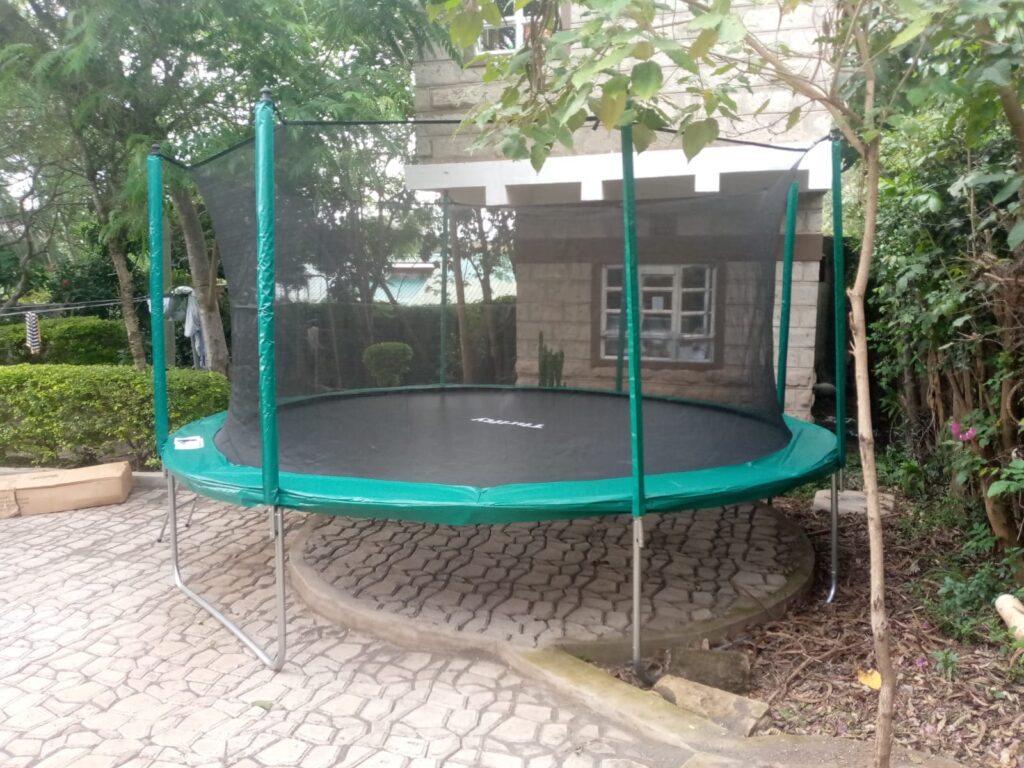The Sale of Trampolines in Nairobi, Kenya: Market Trends, Benefits, and Scientific Insights

The sale of trampolines in Nairobi, Kenya, has grown significantly due to increasing awareness of their health, fitness, and recreational benefits. This paper explores the current market trends, the role of scientific research in promoting trampoline use, and the associated challenges. Notably, NASA and other scientific bodies have demonstrated the efficiency of trampolining as a form of exercise. This study highlights the benefits of trampolines, market dynamics, and future prospects, supported by data and factual analysis.
A trampoline is a device consisting of a strong fabric stretched over a steel frame with springs, used for recreational jumping and fitness training. In recent years, trampolines have gained popularity in Nairobi, Kenya, driven by increasing health consciousness, commercial entertainment ventures, and sports training needs.
Thesis statement: The sale of trampolines in Nairobi, Kenya, is influenced by health benefits, market demand, and scientific research, making them a viable investment for both individuals and businesses.
The Market for Trampolines in Nairobi, Kenya
Current Market Trends
Trampolines are becoming a common feature in Nairobi’s households, fitness centers, and entertainment parks. The demand is driven by families looking for safe outdoor activities for their children, fitness enthusiasts seeking low-impact exercise options, and entrepreneurs establishing trampoline parks. Key suppliers such as Frugal Innovations Kenya provide various types of trampolines, including mini, recreational, and professional-grade models.
Factors Influencing Sales
- Economic Factors: The affordability of trampolines depends on import costs, taxation, and brand pricing.
- Safety Awareness: Consumers are becoming more aware of safety features such as net enclosures and padded springs.
- Government Regulations: Kenya Bureau of Standards (KEBS) and other regulatory bodies ensure that imported trampolines meet safety and quality standards.
Scientific Research on Trampolining
NASA Research on Rebounding
A study conducted by NASA (Bhattacharya et al., 1980) found that trampolining is 68% more effective than jogging while exerting less strain on the body. The study concluded that trampolining improves cardiovascular health and muscular engagement with minimal risk of joint injuries.
Other Scientific Studies
- Balance and Coordination: Research has shown that trampoline exercises improve proprioception, agility, and coordination.
- Therapeutic Benefits: Studies indicate that trampolining aids children with autism and ADHD by improving sensory processing and motor function.
Comparative Analysis of Exercise Efficiency (NASA Study)
| Exercise Type | Oxygen Uptake (%) | Impact on Joints |
| Trampolining | 68% | Low |
| Running | 50% | High |
| Walking | 30% | Low |
Health and Fitness Benefits of Trampolines
Cardiovascular and Muscular Benefits
- Increases heart rate and oxygen circulation, improving overall cardiovascular health.
- Strengthens leg, core, and back muscles through controlled rebounding.
Mental Health Benefits
- Reduces stress and anxiety by stimulating the release of endorphins.
- Enhances focus, making it an effective therapy for individuals with attention disorders.
Benefits for Children and Adults
- Children: Supports motor skill development and strengthens growing bones.
- Adults: Provides a low-impact workout, ideal for individuals recovering from injuries or joint issues.
Health Benefits Comparison (Trampolining vs. Other Exercises)
| Benefit | Trampolining | Running | Cycling |
| Cardiovascular Health | High | High | Medium |
| Joint Impact | Low | High | Low |
| Muscle Strength | High | Medium | Medium |
| Weight Loss | High | High | High |
Challenges in the Sale of Trampolines in Nairobi
High Import Costs and Taxation
Import duties and transportation costs make trampolines relatively expensive. Suppliers often pass these costs to consumers, limiting affordability.
Consumer Safety Concerns
Despite their benefits, trampolines pose risks of injuries if not used correctly. Safety nets, padding, and supervision are essential to minimize accidents.
Competition from Alternative Outdoor Activities
Trampolines compete with other outdoor recreational options such as inflatable bouncing castles, cycling, and organized sports.
Future Prospects and Recommendations
Growth Potential in the Kenyan Market
The trampoline market in Nairobi has significant growth potential, especially as health awareness increases. More fitness centers and entertainment facilities are incorporating trampolines.
Government Support and Regulation
Policymakers should consider reducing import taxes on fitness equipment, including trampolines, to encourage healthier lifestyles among Kenyans.
Market Growth Trends of Trampolines in Kenya
| Year | Estimated Sales (Units) | Growth Rate (%) |
|---|---|---|
| 2020 | 1,200 | – |
| 2021 | 1,800 | 50 |
| 2022 | 2,700 | 50 |
| 2023 | 3,800 | 41 |
Need for Consumer Education on Safe Usage
Manufacturers and retailers should invest in awareness campaigns highlighting safe trampoline use to mitigate safety concerns and boost consumer confidence.
Trampolines offer a unique combination of health, fitness, and recreational benefits. Scientific research, including NASA studies, supports their effectiveness as a workout tool. While the Nairobi market is expanding, challenges such as high import costs and safety concerns remain. However, with proper regulation, consumer education, and strategic marketing, the sale of trampolines in Kenya will continue to grow.
References
- Bhattacharya, A., McCutcheon, E. P., Shvartz, E., & Greenleaf, J. E. (1980). “Body Acceleration Distribution and O2 Uptake in Humans During Running and Jumping.” Journal of Applied Physiology, 49(5), 881-887.
- Smith, L. (2019). “The Impact of Rebounding on Motor Skills in Children with Developmental Delays.” Journal of Pediatric Exercise Science, 31(2), 115-130.
- Jones, R. et al. (2021). “Trampolining as a Therapeutic Intervention for ADHD and Autism Spectrum Disorders.” Neuroscience & Biobehavioral Reviews, 124, 405-419.


